Dr. James Fenton Speaks to Florida House of Representatives, Energy & Utilities Subcommittee on December 6, 2011
Below is the transcription of the 12-minute video recording, located here: http://vimeo.com/33415686.
My name is James Fenton, I’m director of the University of Central Florida’s Florida Solar Energy Center here today and I would like to talk to you about manufacturing, manufacturing renewable energy in Florida. Specifically I’ll use examples of photovoltaics; solar to electric panels.

Let’s look at Florida manufacturing jobs as a tale of two salad bowls. The $10.00 bowl made in Florida using Florida materials keeps all the money and all the jobs in Florida. The $9.50 bowl imported from China, manufactured by Chinese, using Chinese materials sends most of the money and the jobs to China. Which purchase is best for Florida?
Florida imports almost all of its energy resources. The citizens of Florida pay $27 billion for electricity and $30 billion for gasoline for a total of $57 billion per year. This compares to our state budget of $70 billion a year. But unlike our state budget, which I hope by the way we spend all that money in the state, most of the $57 billion leaves the state of Florida. We are faced with two energy challenges – How can Florida reduce its imported energy costs and how can Florida’s electricity and transportation fuel be manufactured in Florida? Can we design an energy future which allows Florida to keep our capital in the state, increasing economic activity and produce high-wage jobs. We can and there is a path to do it. I would like to share such a path.
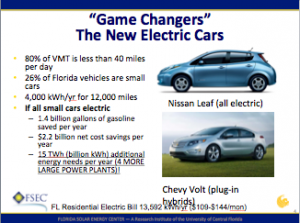
The new electric cars, complete game changers. We have the Nissan Leaf or hybrid plug-ins like the Chevy Volt. They do allow us to keep our capital in the state, increase economic activity and produce high-wage jobs all at less cost than what you are paying today. Currently, 26% of Florida vehicles are small cars. If all the small cars in Florida were electric and in most cases we are using small cars to drive from home to work and back again we would save 1.4 billion gallons of gasoline each year. We would save a net of $2.1B in cost savings and to do this we would have to come up with the equivalent of 15 TWh of electricity or 15 billion kWh a year of electricity. Just 6% of the total amount of electricity that we produce today.
Well, where is the best place to get this energy? Well we already heard that if we look at energy efficiency it is the most cost effective thing we can do. In Florida 50% of our electricity is used in your home. So if you cost effectively save that energy it is a return on you. Now this is a plot then of the annualized energy and improvement costs for a typical 1,600 sq. ft. home in central Florida. You can see here that the base home with no improvements done costs about $2,350 a year in electricity. As we add these energy efficiency improvements we can get down to the point where we save $466. This is a net savings that actually goes into your pocket after you finance these improvements over 30 years over the conventional financing rates. $466 you can put in your pocket. If you want, you can go ahead and buy that slightly more expensive photovoltaics and put it on your roof and still pocket $100 a year in electricity.
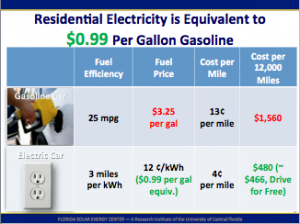
I hope this catches your attention. Residential electricity in Florida is not too expensive. It’s the equivalent to $0.99 a gallon for gasoline! The electric cars are game changers. Let me explain.
The average car on the road today (light truck, light duty vehicle) gets 25 mpg . At $3.25 a gallon that is $0.13 per mile driven. If you look at electricity the electric cars that are produced today get 3 miles per kWh. At our residential electricity rate of $0.12 per kWh you can drive that car for $0.04 a mile. So you can pay $1,560 on fuel that is not made in Florida or you can pay $480 on electricity that is made in Florida. Now I prefer that electricity be renewable or better yet, do the cost effects of energy efficiency in your house and you can drive for free. That is what that slide shows you.
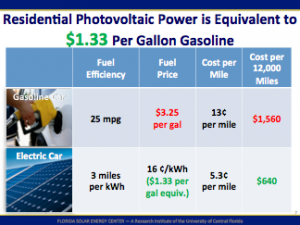
At today’s costs residential photovoltaics on your roof, your power plant, produces electricity at $1.33 a gallon. That is half of what you are paying today. We can’t possibly be saying that renewable energy made in Florida is too expensive. It is gasoline that is too expensive. We have to get off the stuff. You can see here a $1.33 a gallon. Substantial economic savings associated with it.
Now let’s forecast into the future.
Photovoltaics today – $1.33 a gallon; tomorrow – less than a $1. That is what this plot shows.
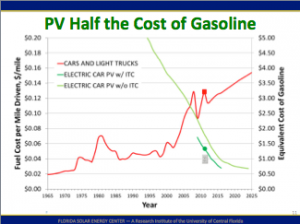
This is a plot of the fuel cost per mile driven for vehicle models years from 1965 all the way up to 2025. You actually use the price per gallon plus the model year car energy efficiency and you can calculate that red curve. Now the projections into the future include the recently passed mpg we are going to 54.5 average mpg in the United States by the year 2025. Unfortunately, the price of fossil fuels is going to go up as well. So you can see over on the right axis I got the relative cost of gasoline, that red square is the $3.25, that I hinted about earlier, that is what you are paying today for a 25 mpg car. If you use instead the photovoltaics on your roof and you take into account the federal income credit you are driving at a $1.33 the is the green circle on the plot. Electricity out of the wall is $1.00. As the price of fossil fuels go up and as the price of photovoltaics continually decrease, we are getting down to the point where yes you can pay less than $1.00 a gallon. We will probably never see $2.00 a gallon gasoline, but you can own the power plant on your roof that will let you drive less than that.
This is a presentation of not only the current cost of levelized cost of wholesale energy in 2010 over on the left, and the lower left that is the levelized cost of retail energy in 2010. The interesting thing is that you will notice that solar photovoltaic utility scales today in 2010 are on the high end of the coal prime prices but as we move forward into the year of 2015, which right now is just three years away, the cost of solar pv at the utility scale is in the low range of new built coal plants. Now look at the levelized cost of retail energy in the years of 2010 and 2015 to you the consumer. Today it is cheaper for you to buy gas, electricity out of the wall than it is photovoltaics. Notice though it is already today in the mid-range of a new coal plant if it could be magically turned on today. If we look into 2015, not only is residential pv on your roof cheaper for you than electricity out of the wall produced from coal, it is comparable to natural gas. I remind you solar and biomass is made in Florida. Making electricity from our resources keeps the money in Florida and it is no longer renewable energy that is too expensive; it is the old way of doing business that is too expensive.
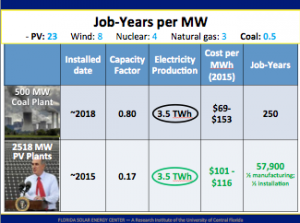
I want to talk to you a bit about jobs. You may have heard in the renewable area, we generate a lot more jobs per megawatt than we do in the traditional fossil fuels. Now you will notice up there that photovoltaics are listed at 23 jobs per MW. Those 23 jobs are based not only on the operation of the power plant, which is what we do traditionally with fossil fuel power plants, but that’s in the manufacturing of that power plant. And I want things made in Florida. That also includes the operation cost of that as well. But that is per MW. What we need to do is compare equivalent amounts of electricity generation. And these two examples I have here I have a 500 MW coal plant and I have a 2,518 MW PV plant. They both make the same amount of electricity in a year, 3.5 TWh. That’s what we care about, how much electricity does it make? By the year 2015, the price of the PV utility grade solar power plant is in the mid-range of the price of the coal plant and the coal plant hasn’t been turned on. It takes 8 years to go build one. We can be generating this PV in Florida today if we allow our utilities to recover the costs. Let’s look at the jobs, 58,000 job years in the case of photovoltaics. If you want to take a job year and make it last ten years, that’s 5,800 jobs. If I build one PV power plant I replace all the workers that have been laid off at Kennedy Space Center. One power plant.

How can Florida displace 67% of OPEC oil imports, create 238,000 job years, and save $2.1 billion a year? It’s simple, we build four PV power plants, the size I just mentioned to you. That would generate 238,000 jobs and by the time those power plants are probably turned on by the year 2015 they are the most cost effective thing to do.
We can convert all our small cars in Florida. Now you may be concerned that the upfront cost of an electric car is more expensive than the upfront cost of a gasoline car, that’s true, it is. But within five years they’re equal in the total cost of operation and most of you finance the cost of a car over five years. So what is preventing us from doing this? Let’s allow the utilities to go ahead and put meters in your home and at work. That is what we need to do.
We can save $2.1 billion a year. If we make the commitment we want to manufacture renewable energy in Florida for transportation. Whether it is biomass to electric or photovoltaics I’m OK. Make it in Florida.

Let’s look again at Florida manufacturing jobs as a tale of two salad bowls. But instead of salad bowls let’s look at the total value of the photovoltaic power plants, large and small, industrial, commercial, utility scale and the small electric cars we are going to purchase. That adds up to a total of $150 billion by the time we get done with that purchase. Except us. Are we going to make the PV panels in Florida? The batteries and the electric cars in Florida? Or will they be imported? Do we want to save money? Do we want to maximize job creation? Do we really want to keep capital in Florida? If so, the Sunshine State must create a renewable market in Florida.
I agree totally with your common sense solution to the number 1 economic issue facing our state and our country.
What was the result of your testimony before the legislature?
Are they seeking a political solution that establishes themselves over the data you have presented, thus stalling the economic growth in the state.
Where can training be obtained to secure a career in the Florida Renewable Energy market?
We are interested in starting a solar panel manufacting company in Florida. Would apprciate any help that could be provided.
The cost of PV vs. gasoline graph was very interesting to see, and certainly, as the cost of fossil will only rise, it’s really a no-brainer to start using solar for transport. Well, at least for the public transport and the mid-range price point automobiles. Those who want to burn gas and run fast, can pay for it. Limprov the gretsch g5120 review guy.
First, great presentation, just finished watching it.
Second, this huge issue in the whole country. Basically, we need to create more jobs for our people. This is a great way to do it. However, big companies don’t think this way. They don’t care about creating jobs here, in our country. They only look how to maximize their profits and minimize costs. And they achieve that by going overseas to search for cheap labor.
Cheers!
Ups, I forgot, one more thing. 🙂
@Tom Colombo
If you are interested in solar energy and solar panels you can visit us at Alternative Energy and maybe you find something interesting!
Cheers!
Great article, I enjoyed it! I agree that it would be better for our country to manufacture solar panels and electric cars here in Florida, but that means higher manufacturing costs for private companies and smaller profits. No one wants to open manufacturing company in USA if he can get same product manufactured in China for significantly less money, which means higher profit. What about that?
Amanda http://www.solarpowercentre.com
The key to good solar paneling is having a home that is faced west and east. This way when the sun comes up your panels are ready for direct sunlight. As an electrician in FL not too many people in the neighborhood use solar panels but I think its becoming more popular. It’s a great technology that I hope takes over the world.
I think it’s inevitable that solar is the dominate form of energy used by North Americans. What ever the fossil fuelests say it is going to run out, it’s just a matter of time. I think I’m betting on solar in a big way because it just is better for the planet. Makes you feel good about leaving the lights on. Ha!
Cheers,
Ash
I liked your infographics, think there very helpful. 3 miles per kwh, think thats a good rate in the long term too.
The solar industry is now creating more jobs in the US than the fossil fuel market is! If you have the opportunity to, invest in the solar industry! Thanks for sharing this information.